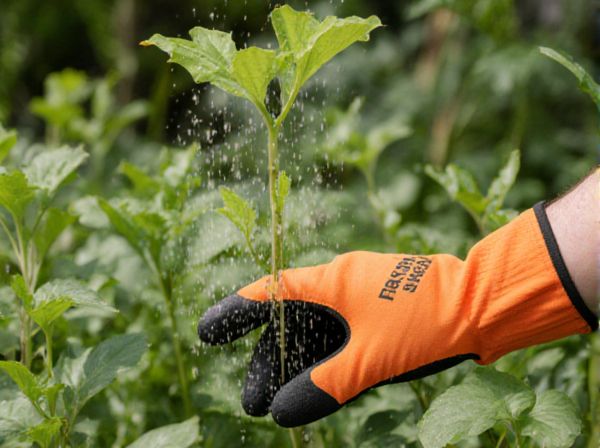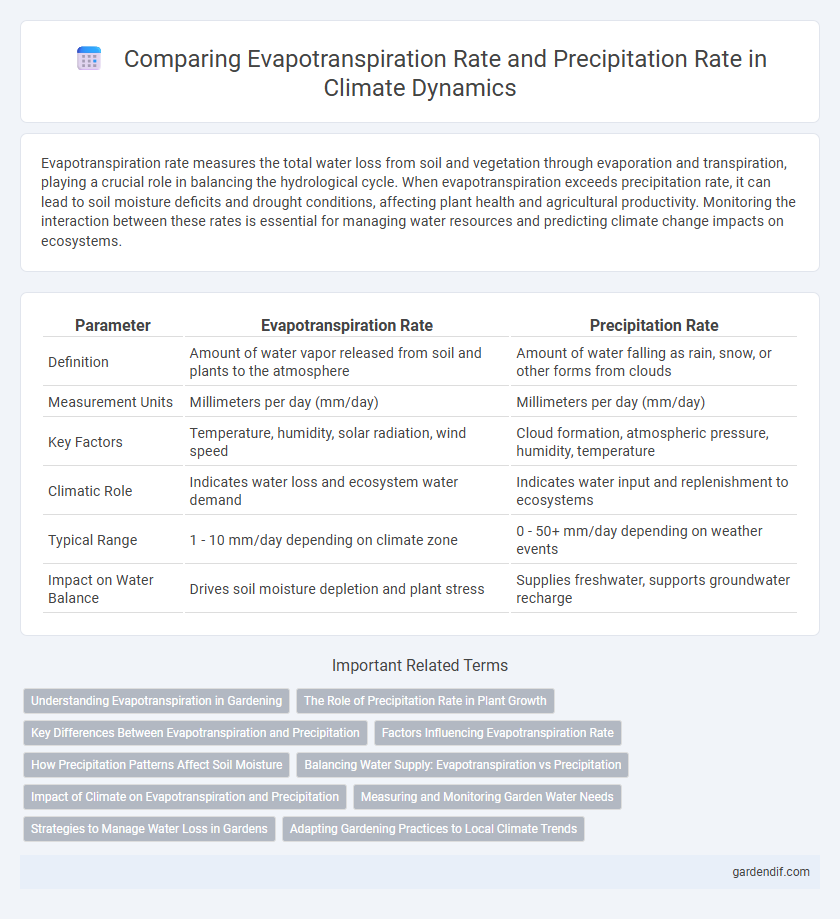
Evapotranspiration Rate vs Precipitation Rate Illustration
Evapotranspiration rate measures the total water loss from soil and vegetation through evaporation and transpiration, playing a crucial role in balancing the hydrological cycle. When evapotranspiration exceeds precipitation rate, it can lead to soil moisture deficits and drought conditions, affecting plant health and agricultural productivity. Monitoring the interaction between these rates is essential for managing water resources and predicting climate change impacts on ecosystems.
Table of Comparison
| Parameter | Evapotranspiration Rate | Precipitation Rate |
|---|---|---|
| Definition | Amount of water vapor released from soil and plants to the atmosphere | Amount of water falling as rain, snow, or other forms from clouds |
| Measurement Units | Millimeters per day (mm/day) | Millimeters per day (mm/day) |
| Key Factors | Temperature, humidity, solar radiation, wind speed | Cloud formation, atmospheric pressure, humidity, temperature |
| Climatic Role | Indicates water loss and ecosystem water demand | Indicates water input and replenishment to ecosystems |
| Typical Range | 1 - 10 mm/day depending on climate zone | 0 - 50+ mm/day depending on weather events |
| Impact on Water Balance | Drives soil moisture depletion and plant stress | Supplies freshwater, supports groundwater recharge |
Understanding Evapotranspiration in Gardening
Evapotranspiration rate represents the combined process of water evaporation from soil and transpiration from plants, directly influencing soil moisture levels essential for gardening. Comparing evapotranspiration with precipitation rate allows gardeners to determine water deficits or surpluses, guiding irrigation schedules to maintain optimal plant health. Monitoring these rates enhances water use efficiency, reduces plant stress, and supports sustainable garden management under varying climatic conditions.
The Role of Precipitation Rate in Plant Growth
The precipitation rate directly influences soil moisture availability, which is critical for maintaining optimal evapotranspiration rates in plants. Adequate precipitation supports continuous water uptake, enabling efficient photosynthesis and nutrient transport essential for growth. Insufficient rainfall leads to reduced soil moisture, causing stomatal closure and limiting evapotranspiration, thereby hindering plant productivity.
Key Differences Between Evapotranspiration and Precipitation
Evapotranspiration rate represents the combined process of water evaporation from soil and transpiration from plants, whereas precipitation rate measures the amount of water, such as rain or snow, falling to the ground. Evapotranspiration influences soil moisture depletion and plant water use efficiency, while precipitation replenishes soil moisture and surface water sources. Understanding these dynamics is crucial for accurate climate modeling, water resource management, and agricultural planning.
Factors Influencing Evapotranspiration Rate
Evapotranspiration rate is influenced by factors such as temperature, humidity, wind speed, and solar radiation, which regulate the energy available for water vaporization. Vegetation type and soil moisture availability also play significant roles, as dense vegetation and moist soils enhance transpiration and evaporation processes. Understanding these variables is crucial for accurate climate modeling and water resource management in different ecosystems.
How Precipitation Patterns Affect Soil Moisture
Precipitation patterns directly influence soil moisture by determining the amount of water available for infiltration and storage in the soil profile. Low or irregular precipitation reduces soil water content, limiting evapotranspiration rates as plants experience water stress. Consistent, moderate precipitation enhances soil moisture, supporting higher evapotranspiration and maintaining a balanced hydrological cycle in terrestrial ecosystems.
Balancing Water Supply: Evapotranspiration vs Precipitation
Evapotranspiration rate and precipitation rate are critical factors in balancing regional water supply and demand. When evapotranspiration exceeds precipitation, soil moisture depletion and drought conditions are likely to occur, affecting agricultural productivity and ecosystem health. Precise monitoring of these rates helps manage water resources by optimizing irrigation scheduling and ensuring sustainable water conservation practices.
Impact of Climate on Evapotranspiration and Precipitation
Climate variations significantly influence evapotranspiration rates, with higher temperatures accelerating water loss from soil and vegetation, intensifying drought conditions. Changes in atmospheric moisture and wind patterns directly affect precipitation rates, altering the distribution and intensity of rainfall. The balance between evapotranspiration and precipitation is crucial for maintaining regional water cycles, impacting agricultural productivity and ecosystem health.
Measuring and Monitoring Garden Water Needs
Accurately measuring evapotranspiration rate (ET) alongside precipitation rate provides essential data for optimizing garden irrigation schedules, ensuring plants receive sufficient water without waste. Soil moisture sensors and weather stations can continuously monitor ET and rainfall, enabling precise adjustments to watering based on real-time climatic conditions. This balance helps maintain healthy plant growth, conserves water resources, and reduces the risk of over or under-watering in diverse garden environments.
Strategies to Manage Water Loss in Gardens
Evapotranspiration rate often exceeds precipitation rate in dry climates, leading to significant water loss in gardens. Implementing mulching techniques and selecting drought-resistant plant species can effectively reduce evaporation and conserve soil moisture. Utilizing drip irrigation systems targets water delivery directly to roots, minimizing losses and optimizing garden water use.
Adapting Gardening Practices to Local Climate Trends
Evapotranspiration rates often exceed precipitation rates in arid and semi-arid climates, necessitating adaptive gardening practices such as drought-resistant plant selections and efficient irrigation systems. Monitoring local evapotranspiration data helps optimize water use by aligning irrigation schedules with actual plant water demand, reducing water waste. Incorporating mulching and soil amendments further conserves moisture, mitigating the disparity between water loss and natural rainfall.
Evapotranspiration Rate vs Precipitation Rate Infographic

 gardendif.com
gardendif.com